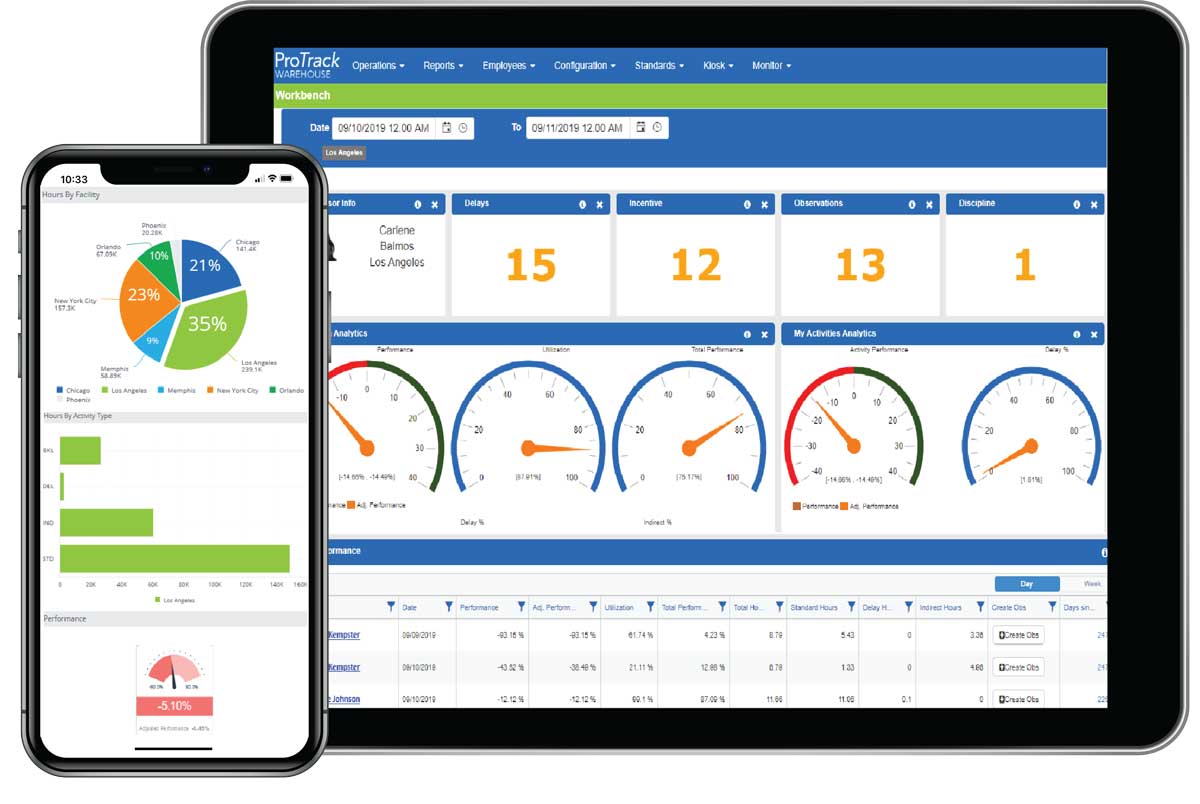Do you have a true labor management system?
In today’s supply chain environments, the best operations have transitioned from labor tracking to labor management software to combat low productivity, high labor cost, high turnover and excessive overtime.
We are breaking down the difference between these systems to demonstrate how labor management software gives your management team the tools necessary to effectively change your environment into a stable high performing operation.
Labor Tracking
Labor Tracking is often-times the process of collecting WMS information from scans as employees are processing assignments. This data is later put into a spreadsheet or database to show management how much the employee accomplished during their shift and what their production rate was.
Performance Reporting
Utilizing scan time information and associated hours against a historical standard is often-times inaccurate performance data and unfair in judging an employees true performance for the following reasons:
- WMS work assignments typically includes an assignment start time and end time which means there are unreported gaps of time between assignments. The lack of “heal to toe” reporting makes performance look significantly better than it really is.
- Over time, this WMS data is entered into a spreadsheet that not only takes added clerical time resulting in the lack of real-time performance data, but it can be plagued with data entry errors.
- Lastly, spreadsheets provide “what happened” well after the fact. Today’s managers need real-time information to properly manage their operation. This type of reporting also doesn’t provide any insight into why something happened or the tools necessary to address or correct the issue.
Performance Standards in a Labor Tracking Environment
One-determinant standards such as Cases per hour or lines per hour are typically when using basic labor tracking tools. This is not the most accurate expectations of time to complete an assignment as it doesn’t take into account the ever-changing input of product mix such as units to line ratios or specific travel distances. Ultimately this means managers are uncomfortable managing their employees to a minimum performance expectation eliminating both the practice of accountability and incentive pay.
Employee Coaching
The foundation of a good performance management program including coaching is real-time productivity information and accurate performance expectations. Both are typically lacking in a labor tracking environment as described above. As a result, most organization don’t have formal coaching programs to help those employees who are struggling to perform at the standard.
Labor Management Systems
Labor Management Software, as different from labor tracking, does provide real-time reporting, the opportunity to build accurate multi-determinant standards, and more importantly, the management tools your floor managers need to operate a high performance operation. The following are a representative list of Tier 1 Labor Management Systems functions:
- Calculation of multi-determinant standards including calculated travel distance and time allowed.
- Labor Planning
- Accurately determine labor requirements by work area and intelligently assigns the most qualified resources resulting in a least cost execution strategy.
- Real-time Reporting
- Make educated decisions based on current information at your fingertips.
- Learning Curves
- The use of defined learning curves by activity is a way to assure that your standards are fair to new associates while they are gaining experience and typically results in the level of training required to retain new employees.
- Incentive Pay
- Now that you have accurate standards in place, bridge the wage gap and increase retention by offering incentive performance programs to engage employees.
- Observation and Coaching
- Set up alerts for managers so that they can identify individuals who may need assistance in achieving the minimum performance expectations and automatically create a coaching session designed to help them get back on track. This increased engagement will not only result in more employees performing at the minimum performance level, but increase employee retention.
- BI Analytics
- Leverage advanced data filters using real time data and long-term history to help managers create dynamic, and visual reports for business insights.
ProTrack Labor Management Software
Labor management strategy and ProTrack software can take the data collection of labor tracking to the next level by collecting real time information from multiple sources to create a combined view of employee activity, utilization and performance. Armed with real-time operational data, management can identify where to focus their attention and make informed decisions.


ProTrack Labor Management Software provides tools for managers to improve labor performance, employee engagement, and foster a culture of continuous improvement.

